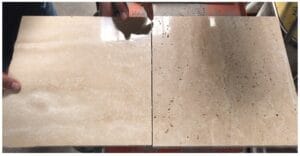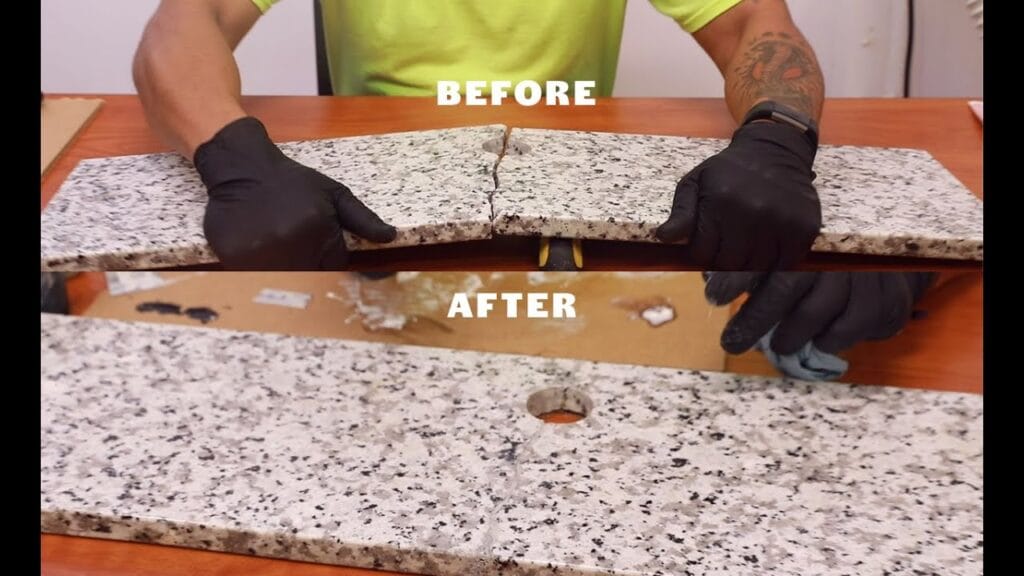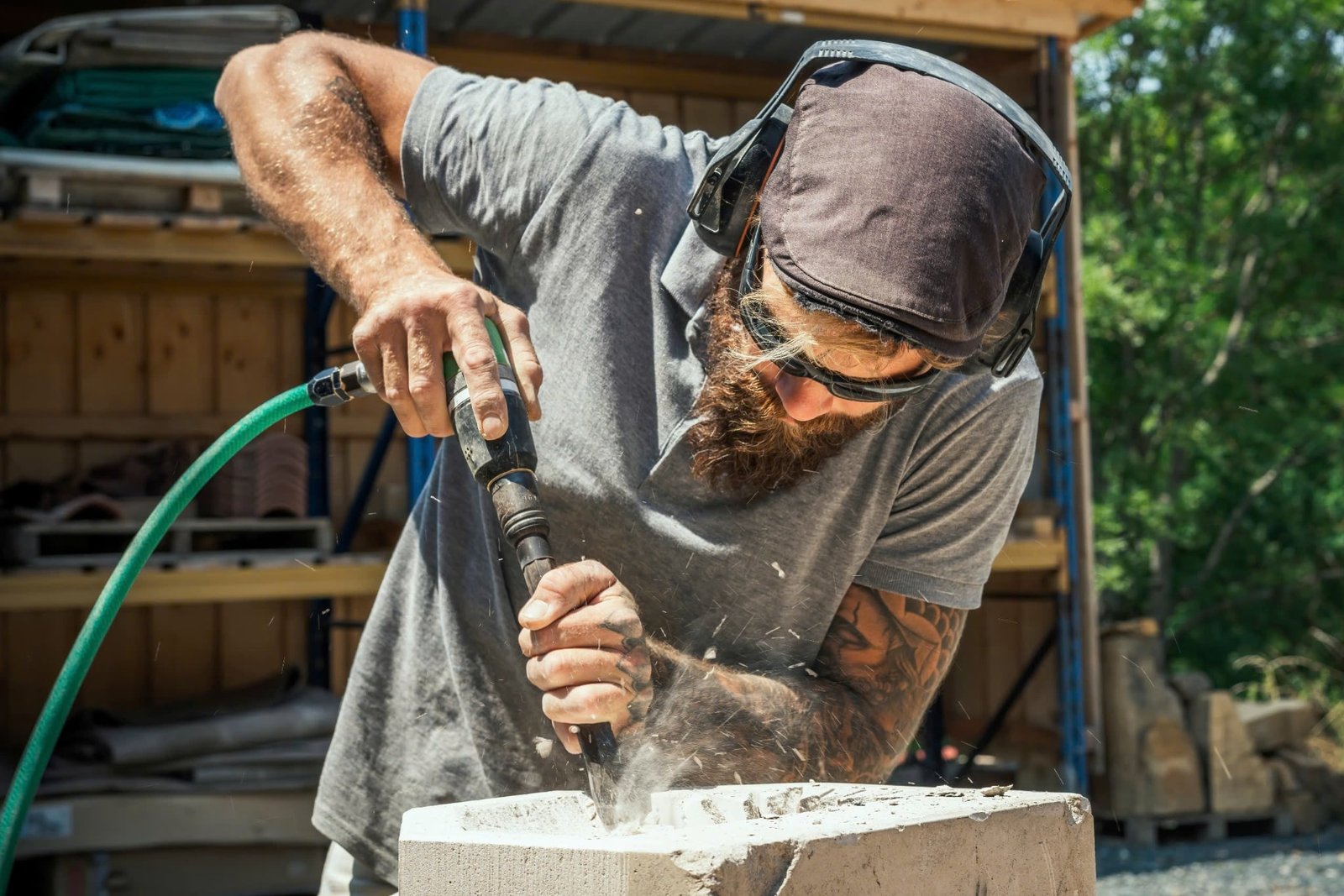
Granite countertops are beloved for their natural beauty, strength, and resistance to heat and scratches.
Granite countertops are beloved for their natural beauty, strength, and resistance to heat and scratches. Whether you’ve chosen granite kitchen countertops or stylish granite bathroom countertops, it’s natural to expect them to last for decades. However, granite is not immune to damage. Over time, chips, pits, or even small holes may appear on the surface due to wear, impact, or natural imperfections.
Fortunately, you can repair these issues and restore the surface with minimal hassle. This comprehensive guide shows you how to fill chips and holes in granite countertops, using expert-backed techniques for both polished granite countertops and honed granite countertops.

Why Chips and Pits Form on Granite Countertops
Although granite slabs for countertops are tough, they’re not indestructible. Common causes of chips and holes include:
- Dropping heavy pans or utensils
- Natural fissures in the stone
- Weak spots around sinks and edges
- Wear on custom granite countertops from years of use
- Improper handling during transport or installation
Understanding the cause helps prevent future damage and extends the life of your countertops.
🔧 Tip: When transporting granite, always use proper gear like ratchet tie down straps to prevent accidental cracking or chipping.

Tools and Materials You’ll Need
To repair chips and holes on granite surfaces, gather the following:
- Clear or color-matched epoxy resin or acrylic adhesive
- Razor blade or putty knife
- Polishing compound
- Masking tape
- Acetone or alcohol
- Soft cloth
You can find granite repair kits at home improvement stores or online, ideal for black granite countertops, white granite countertops, blue pearl granite countertops, and more.
Step-by-Step Instructions to Fill Chips in Granite Countertops
1. Clean the Area Thoroughly
Before applying any adhesive or epoxy, ensure the area is free of dust, grease, or debris:
- Wipe the chip or pit with a cloth dampened with acetone or alcohol.
- Let it dry completely.
💡 If you’re new to granite maintenance, check out this summary about granite to learn more about the material’s characteristics.
2. Tape Off the Surrounding Area
Use painter’s or masking tape to cover the area around the chip. This protects the surrounding surface and ensures a clean application.
3. Apply the Epoxy or Acrylic Adhesive
- Choose a clear resin for polished granite countertops or a color-matched filler for honed or textured finishes.
- Use a toothpick or applicator to fill the chip or hole completely.
- Slightly overfill to allow for shrinkage during curing.
🧽 Pro Tip: For deep holes, apply the resin in layers, letting each layer partially cure before adding the next.
4. Allow the Adhesive to Cure
Refer to the manufacturer’s instructions. Most epoxies cure fully within 24 hours.
🚫 Do not touch, clean, or place items near the repair area until it cures completely.
5. Level and Polish the Surface
- Once cured, carefully scrape the excess epoxy with a razor blade to level it with the granite surface.
- Polish with a granite polishing compound to blend the repaired area and restore shine.
✨ If your countertop has a leathered or honed finish, refer to How to Hone Leathered Granite Countertops for proper surface treatment techniques.
How to Treat and Maintain Repaired Granite Countertops
After filling chips or holes, ensure proper maintenance to avoid further damage:
- Use cutting boards to prevent nicks and chips
- Re-seal the surface periodically (every 1–2 years)
- Clean spills immediately to avoid staining
🧽 Learn more in How to Treat Granite Countertops.
When to Call a Professional
While many minor chips are DIY-friendly, you should call a local granite fabricator or countertop specialist for:
- Large cracks or holes
- Damage near seams or sink cutouts
- Structural compromise
- Matching repairs for exotic colors like brown granite countertops or blue pearl granite countertops
Look for:
- Granite countertop installation services
- Granite countertop showroom [location]
- Top-rated granite countertop installers near me
Granite Countertops vs. Quartz: Which Is More Durable?
While granite is highly durable, quartz countertops offer increased resistance to chips due to their uniform engineered structure.
Compare them here:
Pros and Cons of DIY Granite Repair
Pros:
- Affordable and accessible
- Quick fix for surface blemishes
- Restores value and appearance
Cons:
- May be difficult to color match
- Risk of overfilling or dull finish
- Not suitable for structural repairs
🛠 Consider investing in affordable granite countertops for modern kitchens that are professionally sealed and less prone to damage.
Final Thoughts: Granite Chip Repair Is Easy and Effective
Filling chips and holes in granite countertops is a straightforward process that restores the look and integrity of your kitchen or bathroom surfaces. With the right tools, a bit of patience, and the steps outlined above, your countertop can look almost brand new again—whether you’re working with black, white, brown, or custom granite countertops.
If you’re unsure about the type of finish or best repair approach, consult with a local expert or refer to a [granite countertop showroom in your area].

